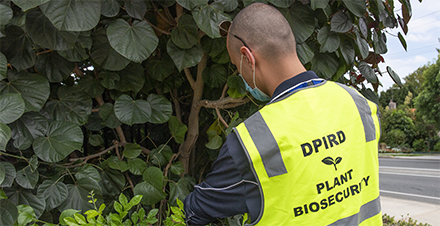Perth’s Hyde Park could lose up to 20% of its trees due to an infestation of an exotic South East Asian beetle known as ployphgous shot-hole borer which tunnels into a tree and plants a fungus that blocks nutrients and water. Source: Timberbiz
A single female borer can fly up to 400 metres and start new colonies quickly. It is believed that the borer came into Perth via untreated wood from Asia.
 “It’s not clear how this destructive borer made its way into WA, but it is clear that we need everyone to follow the strict biosecurity rules at our airports and borders, to keep unwanted pests out,” Western Australia’s Agriculture and Food Minister Jackie Jarvis said.
“It’s not clear how this destructive borer made its way into WA, but it is clear that we need everyone to follow the strict biosecurity rules at our airports and borders, to keep unwanted pests out,” Western Australia’s Agriculture and Food Minister Jackie Jarvis said.
“An unprecedented biosecurity response has been underway for more than two years to stem the spread of this pest.
“DPIRD is working around the clock to eradicate it and is consulting with scientists from California and South Africa to learn from their experience in managing the borer.
“However, it is imperative that we work together as a community to deal with this invasive pest.”
Around 180 trees in Hyde Park are targeted for removal including old Moreton Bay Figs and London Plane Trees.
The Cook Government is urging the Western Australian community to help stop the spread of the tiny beetle, which was first detected in Fremantle in mid-2021.
With no known treatments currently available, tree removal is the only way to prevent this invasive pest from rapidly reproducing.
This means a number of infested trees across Perth will require pruning or removal by arborists including at Hyde Park, Lake Claremont, Kings Park, and Perth Zoo.
Department of Primary Industries and Regional Development (DPIRD) is doing everything it can to stop the spread of the borer, as part of a national biosecurity response, and has launched the biggest surveillance program in the Department’s history.
DPIRD response staff have already inspected more than 1.5 million trees on more than 50,000 properties, as well deployed 3,000 traps to help track the borer.
There is also a quarantine area in place, covering most of the Perth metropolitan area.
It is vital that residents are aware of the restrictions on the movement of wood and plant material from their properties, as it could spread the borer.
To date there’s been excellent support from the public and local governments, however ongoing community vigilance is vital to assist the State’s efforts to stop this invasive pest.
The public can help by keeping an eye out for signs of the borer, and reporting it to the My Pest Guide Reporter app or website mypestguide.agric.wa.gov.au
Symptoms can include tiny holes in a tree trunk, discolouration, staining or sawdust.






